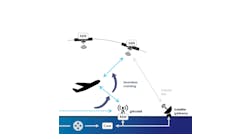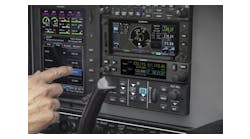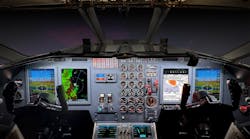The use of Radio Frequency Identification (RFID) for air travel brings one connection immediately to mind: keeping track of passengers’ baggage. The use of RFID to reduce the rate of lost bags and improve the overall efficiency of the baggage handling process has received much media and industry attention. As it turns out, however, suitcases are only the beginning.
Indeed, RFID — which uses tags that transmit data to readers using low-energy radio waves — has proven itself useful at keeping tabs on luggage. Boeing and FedEx used Motorola equipment to prove its viability in 2004 tests, and the Federal Aviation Administration (FAA) approved the use of passive tags on aircrafts in May 2005. Hong Kong International Airport and Las Vegas McCarran International Airport have been successful early adopters of RFID baggage tracking systems.
Now, RFID is moving into other parts of the aircraft and other facets of the industry. While some physical and regulatory hurdles remain before it can be fully adopted, the technology is showing considerable promise.
Aircraft parts
The May 2005 FAA ruling also permits operators to use passive RFID tags on aircraft parts. The federal government requires individual tracking of parts and their maintenance histories, and the current industry standard for compliance uses bar codes.
In the wake of the ruling, Boeing mandated RFID tagging for 2,000 parts in its new 787 Dreamliner, scheduled to enter service in 2010. Manufacturers must affix ultra-high frequency (UHF) tags to the parts before shipping them to Boeing, and airlines who buy the planes will be able to encode the maintenance data directly on the tags.
Bar code readers require line-of-sight access to their tags, which makes it hard to use them in the cramped mechanical and avionics spaces of an aircraft. In some cases, crews even have to use mirrors to see part numbers, which they key in by hand. Plus, bar code reads are only 75 to 80 percent accurate.
In contrast, passive RFID allows users to improve their daily processes and productivity. For example, crews can scan all the parts in a section of the plane in a single sweep. RFID removes both bar code and human error from the data entry process, and averages better than 99 percent accuracy. In the shop, a mechanic can determine a part’s history even if there is no access to a database, because the information is there in the tag. Between flights, a ground crew can save valuable turnaround time by using hand-held RFID scanners to account for tagged life jackets and emergency equipment as required by law.
Other industry forays into RFID parts tagging have been ground-based. In Hamburg, Germany, Siemens teamed with Airbus for a successful test of RFID in tracking materials used to paint and fit out its new A380 passenger planes. Goodrich Aviation Technical Services, the largest third-party provider of aviation maintenance, repair, and overhaul (MRO) services, is taking a hard look at the possible implementation of RFID in its Everett, WA, facility, which processes more than 175,000 parts per year.
The prospects for RFID management of aviation parts include the same supply chain efficiencies that RFID has brought to other industries. The technology can also enhance security and safety by verifying compliance with foreign object detection (FOD) zones around aircraft undergoing maintenance.
Cargo
Unit Load Devices (ULDs), the specially shaped cargo units designed to speed the loading and unloading of aircraft cargo spaces, carry goods of every description and value. ULDs are also valuable themselves, whether owned by a single carrier or shipper or shared through multilateral agreements.
The Luxembourg-based carrier Cargolux reported losing 2 percent of its ULDs in 2003, and Lufthansa and Air France lose 5 to 6 percent of them each year. In the most striking cases, people near airports in developing countries have even adopted ULDs as housing. Many of these losses are the result of tracking breakdowns. Cargolux officials estimate that reducing its ULD loss rate by 1 percent each year would save €60,000 (almost $80,000) in direct costs, not counting staff time, insurance costs, and the cost of keeping extra units at each station.
RFID tagging of ULDs and their contents is catching on. In 2006, a major airline used Motorola tags and readers in a successful test of air cargo tracking that generated 100 percent read rates at airports in Florida and Canada. Perhaps more importantly, the pilot showed that RFID transmissions didn’t interfere with normal operations.
Mobile technology for capturing and using the data on tags — such as wearable and hand-held readers linked wirelessly to enterprise management software — is one development that will speed the adoption of the use of RFID in air cargo. Due to the enhanced granularity and visibility of information generated by RFID tracking, its adoption is sure to spread, and may even become a value-added service that airports offer to cargo companies.
Aircraft turnaround
Airport turnaround times are a major concern for the industry. A recent study at the Institute for Manufacturing in Cambridge showed that the need for airlines to minimize costs and improve on-time departures is greater than ever: the average departure delay of aircraft is 17.4 minutes, which equates to departure delays of more than 605 hours (25 days) every year. The cost of UK departure delays in 2005 was more than £650 million (about $1.28 billion in today’s dollars).
The International Air Transport Association (IATA), together with SITA, is sponsoring a study to explore how RFID can improve turnaround times in order to reduce aircraft delays and, ultimately, costs.
Postal operations
Vacationers and business travelers alike may be surprised to learn that the U.S. Postal Service is commercial aviation’s largest customer. Each year seven leading U.S. carriers transport more than 450 million pounds of mail, driving more than $250 million in annual revenue.
Lost mail bothers people as much as lost baggage does. It also bothers the airlines — because if the mail is not appropriately tracked and doesn’t turn up where it’s supposed to arrive, they don’t get paid. The current system of tracking mail bags on commercial flights uses bar code scanning, and the Postal Service requires two or even three successful scans of each bag before it will pay for the shipment. A move to RFID, which can track multiple items in a single pass without individual line-of-sight scans, would increase the speed and accuracy of accounting for all that mail.
While a move to RFID in postal aviation would require approval from the postal service, this is a natural progression of technology, a factor that is likely to weigh positively for a service that has traditionally valued the use of technology in other parts of its operations.
Horizons for RFID
RFID is poised to spread through the aviation industry just as it has in manufacturing, retail, and other environments — but aviation presents special challenges.
Two of them — the regulatory environment in the industry and the physical environment of an aircraft in flight — go hand in hand. The FAA has approved the use of passive RFID tags while planes are on the ground, but active and battery-assisted tags remain off-limits, and no RFID system can be used when a plane is flying or even on a taxiway.
Boeing has conducted tests of active tags on aircraft, with promising results — the tags didn’t interfere with flight operations, and their longer read range meant that ground crews could scan locations throughout a plane without going inside, simply by opening one of the main hatches. If the FAA approves them for widespread use, active tags paired with temperature or other sensors could send real-time maintenance information to onboard wireless networks.
The physics of flight also involves shock, vibration, dirt, temperature extremes, and an abundance of metal — a surface that hasn’t always meshed well with RFID tagging. New tag technologies, including ceramic and metal-friendly mountings, will allow the technology to move past these hurdles.
RFID systems must also account for the diversity of operators in aviation. A single flight might involve an airline, an airport management organization, a cargo company, a catering company, the U.S. Postal Service, and other distinct entities. Some RFID systems may be specific to a single aircraft that will visit multiple locations; others will be keyed to a single airport campus that welcomes planes and cargo from around the world.
The solution lies in wireless system architecture such as Motorola’s Wireless Next Generation (Wi-NG) switching platform, which can manage complex networks in a way that’s operationally seamless and scalable. Many RFID systems can integrate with Wi-Fi, Wi-Max, and other data management networks as well. The key is enterprise mobility: an airport is a dynamic environment, and nothing is as mobile as an aircraft or its contents. An RFID system that succeeds in an aviation environment will need to function through readers and IT hardware that can bring data back to the enterprise from wherever they’re needed.
From building planes to operating them safely, to filling them with profitable payloads, RFID has a great deal to offer the aviation industry, and the major players in aviation have shown leadership in testing and adopting the technology. When the FAA opens the door to broader use of RFID tagging on the ground and in the air, RFID will give everyone in aviation a smoother ride.
Joe White is vice president of Business Development and Marketing for Motorola’s Enterprise Mobility business’s RFID Division.



